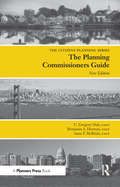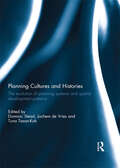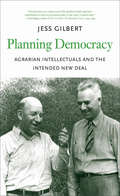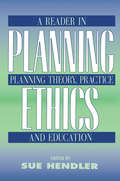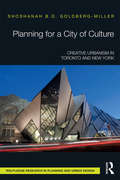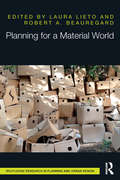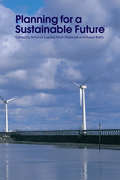- Table View
- List View
Planning Cities With Young People and Schools: Forging Justice, Generating Joy
by Deborah L. McKoy Amanda Eppley Shirl BussOffering the overlooked but essential viewpoint of young people from low-income communities of color and their public schools, Planning Cities With Young People and Schools offers an urgently needed set of best-practice recommendations for urban planners to change the status quo and reimagine the future of our cities for and with young people. Working with more than 10,000 students over two decades from the San Francisco Bay Area, to New York, to Tohoku, Japan, this work produces a wealth of insights on issues ranging from environmental planning, housing, transportation, regional planning, and urban education. Part I presents a theory of change for planning more equitable, youth-friendly cities by cultivating intergenerational communities of practice where young people work alongside city planners and adult professionals. Part II explores youth engagement in resilience, housing, and transportation planning through an analysis of literature and international examples of engaging children and youth in city planning. Part III speaks directly to practitioners, scholars, and students alike, presenting "Six Essentials for Planning Just and Joyful Cities" as necessary precursors to effective city planning with and for our most marginalized, children, youth, and public schools. For academics, policy makers, and practitioners, this book raises the importance of education systems and young people as critical to urban planning and the future of our cities.
Planning Cities With Young People and Schools: Forging Justice, Generating Joy
by Deborah L. McKoy Amanda Eppley Shirl BussOffering the overlooked but essential viewpoint of young people from low-income communities of color and their public schools, Planning Cities With Young People and Schools offers an urgently needed set of best-practice recommendations for urban planners to change the status quo and reimagine the future of our cities for and with young people. Working with more than 10,000 students over two decades from the San Francisco Bay Area, to New York, to Tohoku, Japan, this work produces a wealth of insights on issues ranging from environmental planning, housing, transportation, regional planning, and urban education. Part I presents a theory of change for planning more equitable, youth-friendly cities by cultivating intergenerational communities of practice where young people work alongside city planners and adult professionals. Part II explores youth engagement in resilience, housing, and transportation planning through an analysis of literature and international examples of engaging children and youth in city planning. Part III speaks directly to practitioners, scholars, and students alike, presenting "Six Essentials for Planning Just and Joyful Cities" as necessary precursors to effective city planning with and for our most marginalized, children, youth, and public schools. For academics, policy makers, and practitioners, this book raises the importance of education systems and young people as critical to urban planning and the future of our cities.
Planning Commissioners Guide: Processes for Reasoning Together
by C Gregory Dale Benjamin A Herman Anne McBrideAcross the country, communities rely on their planning commissions for guidance. But who guides the planning commissioners? This step-by-step guidebook gets new commissioners off on the right foot and helps experienced commission members navigate their roles. The authors, all practicing planners, have worked extensively with planning commissions for decades. They have watched commissioners scramble up a steep learning curve, sit in the hot seat of controversy, and strive to make sound decisions for the places they call home. In this helpful handbook, the authors share ideas, insights, and information to help commissioners succeed. Eight detailed chapters cover everything from the nuts and bolts of development applications to the nuances of legal issues to the part commissioners play in long-range planning. Readers will learn how to prepare for their first commission meeting, review a development plan, invite productive public input, and steer clear of ethical dilemmas. Added resources include a glossary of planning terms, a list of training resources, and the American Planning Association’s Statement of Ethical Principles in Planning. For anyone serving on a planning commission, The Planning Commissioners Guide is essential reading.
Planning Commissioners Guide: Processes for Reasoning Together
by C Gregory Dale Benjamin A Herman Anne McBrideAcross the country, communities rely on their planning commissions for guidance. But who guides the planning commissioners? This step-by-step guidebook gets new commissioners off on the right foot and helps experienced commission members navigate their roles. The authors, all practicing planners, have worked extensively with planning commissions for decades. They have watched commissioners scramble up a steep learning curve, sit in the hot seat of controversy, and strive to make sound decisions for the places they call home. In this helpful handbook, the authors share ideas, insights, and information to help commissioners succeed. Eight detailed chapters cover everything from the nuts and bolts of development applications to the nuances of legal issues to the part commissioners play in long-range planning. Readers will learn how to prepare for their first commission meeting, review a development plan, invite productive public input, and steer clear of ethical dilemmas. Added resources include a glossary of planning terms, a list of training resources, and the American Planning Association’s Statement of Ethical Principles in Planning. For anyone serving on a planning commission, The Planning Commissioners Guide is essential reading.
Planning Cultures and Histories: The evolution of Planning Systems and Spatial Development Patterns
by Dominic Stead, Jochem de Vries and Tuna Tasan-KokThis book addresses the influences of planning cultures and histories on the temporal evolution of planning systems and spatial development. As well as providing an international comparative perspective on these issues, the contributions to the book also engage in a search for new conceptual frameworks and alternative points of view to better understand and explain these differences. The book makes three main academic contributions. First, it catalogues some of the key changes in planning systems and the impact on spatial development patterns. Second, it examines the interrelationship between planning cultures and histories from a path-dependency perspective. Third, it discusses the variations in physical development patterns resulting from different planning cultures and histories. Chapters from different parts of the European continent present evidence at different scales to illustrate these aspects. In all cases, the specific combinations of political, ideological, social, economic and technological factors are important determinants of urban and regional planning trajectories as well as spatial development patterns. This book was previously published as a special issue of European Planning Studies.
Planning Cultures and Histories: The evolution of Planning Systems and Spatial Development Patterns
by Dominic Stead Jochem De Vries Tuna Tasan-KokThis book addresses the influences of planning cultures and histories on the temporal evolution of planning systems and spatial development. As well as providing an international comparative perspective on these issues, the contributions to the book also engage in a search for new conceptual frameworks and alternative points of view to better understand and explain these differences. The book makes three main academic contributions. First, it catalogues some of the key changes in planning systems and the impact on spatial development patterns. Second, it examines the interrelationship between planning cultures and histories from a path-dependency perspective. Third, it discusses the variations in physical development patterns resulting from different planning cultures and histories. Chapters from different parts of the European continent present evidence at different scales to illustrate these aspects. In all cases, the specific combinations of political, ideological, social, economic and technological factors are important determinants of urban and regional planning trajectories as well as spatial development patterns. This book was previously published as a special issue of European Planning Studies.
Planning Cultures in Europe: Decoding Cultural Phenomena in Urban and Regional Planning (Urban and Regional Planning and Development Series)
by Frank OthengrafenBringing together an interdisciplinary team from across the EU, this book connects elements of cultural and planning theories to explain differences and peculiarities among EU member states. A 'culturized planning model' is introduced to consider the 'rules of the game': how culture affects planning practices not only on an explicit 'surface' but also on a 'hidden' implicit level. The model consists of three analytical dimensions: 'planning artifacts', 'planning environment' and 'societal environment'. This book adopts these dimensions to compare planning cultures of different European countries. This sheds light not only on the organizational or institutional structure of planning, but also the influence of deeper cultural values and layers on planning and implementation processes.
Planning Cultures in Europe: Decoding Cultural Phenomena in Urban and Regional Planning (Urban and Regional Planning and Development Series)
by Frank OthengrafenBringing together an interdisciplinary team from across the EU, this book connects elements of cultural and planning theories to explain differences and peculiarities among EU member states. A 'culturized planning model' is introduced to consider the 'rules of the game': how culture affects planning practices not only on an explicit 'surface' but also on a 'hidden' implicit level. The model consists of three analytical dimensions: 'planning artifacts', 'planning environment' and 'societal environment'. This book adopts these dimensions to compare planning cultures of different European countries. This sheds light not only on the organizational or institutional structure of planning, but also the influence of deeper cultural values and layers on planning and implementation processes.
Planning Democracy: Agrarian Intellectuals and the Intended New Deal (Yale Agrarian Studies Series)
by Jess GilbertLate in the 1930s, the U.S. Department of Agriculture set up a national network of local organizations that joined farmers with public administrators, adult-educators, and social scientists. The aim was to localize and unify earlier New Deal programs concerning soil conservation, farm production control, tenure security, and other reforms, and by 1941 some 200,000 farm people were involved. Even so, conservative anti–New Dealers killed the successful program the next year. This book reexamines the era’s agricultural policy and tells the neglected story of the New Deal agrarian leaders and their visionary ideas about land, democratization, and progressive social change.
Planning Derry: Planning and Politics in Northern Ireland
by Gerald McSheffreyThe story of the making and eventual implementation of a city and regional plan for the Londonderry area makes fascinating reading. Published in 1968, just before the outbreak of the recent 'troubles', it became the basis for subsequent plans implemented by officials of the Northern Ireland Department of the Environment, the Northern Ireland Housing Executive and dedicated community leaders. Their often heroic commitment to the future of the city and its environs transcends even the worst days of civil strife. The author was one of a small team that made the plan and he places it in context, explains how it came to be made and records the difficulties of planners working in the political circumstances that prevailed. Against the background of the general social, economic and physical conditions of the city and region, he focuses on the housing crisis before elaborating on the making of the plan in particular. Professor McSheffrey stresses that although the story may be of interest to planners and development professionals, it is not an academic study of the planning process. He hopes it will introduce general readers to the importance of planning and the complex social and ethical issues inherent in the process. Planning Derry for example, involved value judgements concerning people and political and religious views in Northern Ireland at the time, but he has tried to be objective and avoid bias or the espousal of a particular political viewpoint. The book is, above all, about the dedication of individuals who believed their planning efforts could make a difference and provide better living conditions and choices for the people of the area. McSheffrey concludes on an optimistic note concerning the future place of Derry in Ireland. As the peace process unfolds, he hopes that perhaps the people of Derry, as they continue to develop and rebuild their city, might become a symbol of liberation from the past and of expectations of a peaceful and prosperous future for all Irish people.
Planning Ethics
by Murray StrausOver the past fifty years professional understanding of planning has changed markedly. In the past, planning was primarily described as a technical activity involving data collection, analysis, and synthesis of physical plans and supporting policies. Now planning is seen as a much broader set of human activities, encompassing the physical world and also the realm of public and social services. Not surprisingly, planners' discussions of ethics have evolved. Professional ethics is regarded by many planners to be limited to a set of rules of behavior regarding interactions with the public, sources of data, government officials, and one another.This shift is symbolized by the evolution of the labels by which ethics is known: from a circumscribed view of professional ethics to a broader concept of ethics in planning; both of which are discussed in this book. Sue Hendler argues that planners recognize that every act of planning pursues certain human values and is a series of statements about what we take to be right or wrong and what we take to represent the highest priorities of the society.Planning Ethics explores planning within alternative moral theories, including liberalism, communitarianism, environmentalism, and feminism. The contributors illustrate the application of these ethical principles in specific planning contexts encompassing community development, land conversion, waste management, electric power planning, and education planning. This is the next generation of thinking on ethics and planning. It will be a centerpiece of every planning curriculum.
Planning Ethics
by Murray StrausOver the past fifty years professional understanding of planning has changed markedly. In the past, planning was primarily described as a technical activity involving data collection, analysis, and synthesis of physical plans and supporting policies. Now planning is seen as a much broader set of human activities, encompassing the physical world and also the realm of public and social services. Not surprisingly, planners' discussions of ethics have evolved. Professional ethics is regarded by many planners to be limited to a set of rules of behavior regarding interactions with the public, sources of data, government officials, and one another.This shift is symbolized by the evolution of the labels by which ethics is known: from a circumscribed view of professional ethics to a broader concept of ethics in planning; both of which are discussed in this book. Sue Hendler argues that planners recognize that every act of planning pursues certain human values and is a series of statements about what we take to be right or wrong and what we take to represent the highest priorities of the society.Planning Ethics explores planning within alternative moral theories, including liberalism, communitarianism, environmentalism, and feminism. The contributors illustrate the application of these ethical principles in specific planning contexts encompassing community development, land conversion, waste management, electric power planning, and education planning. This is the next generation of thinking on ethics and planning. It will be a centerpiece of every planning curriculum.
Planning for a Better Urban Living Environment in Asia (Routledge Revivals)
by Anthony Gar-On Yeh Mee Kam NgFirst published in 2000, this volume explores how Asia has developed very rapidly in the last quarter of the century and will be a main focus of the world in the 21st century. With rapid growth and development, the urban areas in the region are undergoing dramatic changes. An appreciation of the heterogeneous nature of Asian cities and the related planning practices in the first step to understand various urban development problems in the region. This book is a consolidated effort by prominent scholars in Asian planning schools to explore urban development and planning practices in Asia. The book reflects on and examines some of the past and current challenges, and considers future prospects of urban and regional planning, environment, housing, redevelopment and conservation, and planning education in Asia. This book should be useful to students, teachers, researchers, professionals and people who are interested in urban development, planning and environment in Asia.
Planning for a Better Urban Living Environment in Asia (Routledge Revivals)
by Anthony Gar-On Yeh Mee Kam NgFirst published in 2000, this volume explores how Asia has developed very rapidly in the last quarter of the century and will be a main focus of the world in the 21st century. With rapid growth and development, the urban areas in the region are undergoing dramatic changes. An appreciation of the heterogeneous nature of Asian cities and the related planning practices in the first step to understand various urban development problems in the region. This book is a consolidated effort by prominent scholars in Asian planning schools to explore urban development and planning practices in Asia. The book reflects on and examines some of the past and current challenges, and considers future prospects of urban and regional planning, environment, housing, redevelopment and conservation, and planning education in Asia. This book should be useful to students, teachers, researchers, professionals and people who are interested in urban development, planning and environment in Asia.
Planning for a Better Urban Living Environment in Asia
by Anthony Gar-On Yeh Mee Kam NgThis title was first published in 2000. Asia has developed very rapidly in the last quarter of the century and will be a main focus of the world in the 21st century. With rapid growth and development, the urban areas in the region are undergoing dramatic changes. An appreciation of the heterogeneous nature of Asian cities and the related planning practices is the first step to understand various urban development problems in the region. This book is a consolidated effort by prominent scholars in Asian planning schools to explore urban development and planning practices in Asia. The book reflects on and examines some of the past and current challenges and considers future prospects of urban and regional planning, environment, housing, redevelopment and conservation and planning education in Asia. This book should be useful to students, teachers, researchers and professionals and people who are interested in urban development, planning and environment in Asia.
Planning for a Better Urban Living Environment in Asia
by Anthony Gar-On Yeh Mee Kam NgThis title was first published in 2000. Asia has developed very rapidly in the last quarter of the century and will be a main focus of the world in the 21st century. With rapid growth and development, the urban areas in the region are undergoing dramatic changes. An appreciation of the heterogeneous nature of Asian cities and the related planning practices is the first step to understand various urban development problems in the region. This book is a consolidated effort by prominent scholars in Asian planning schools to explore urban development and planning practices in Asia. The book reflects on and examines some of the past and current challenges and considers future prospects of urban and regional planning, environment, housing, redevelopment and conservation and planning education in Asia. This book should be useful to students, teachers, researchers and professionals and people who are interested in urban development, planning and environment in Asia.
Planning for a City of Culture: Creative Urbanism in Toronto and New York
by Shoshanah B.D. Goldberg-MillerPlanning for a City of Culture gives us a new way to understand how cities use arts and culture in planning, fostering livable communities and creating economic development strategies to build their brand, attract residents and tourists, and distinguish themselves from other urban centers worldwide. While the common thinking on creative cities may coalesce around the idea of one goal––economic development and branding––this book turns this idea on its head. Goldberg-Miller brings a new, fresh perspective to the study of creative cities by using policy theory as an underlying construct to understand what happened in Toronto and New York in the 2000s. She demystifies the processes and outcomes of stakeholder involvement, exogenous and endogenous shocks, and research and strategic planning, as well as warning us about the many pitfalls of neglecting critical community voices in the burgeoning practice of creative placemaking. This book is an essential resource in examining the development and sustainability of the global trend of integrating arts and culture in city planning and urban design that has become an international phenomenon. Perfect for students, scholars, and city-lovers alike, Planning for a City of Culture illuminates the ways that this creative city trend went global, with the two case study cities serving as perfect illustrations of the power and promise of arts and culture in current and future municipal strategies. Please visit Shoshanah Goldberg-Miller's website for more information and research: www.goldberg-miller.com
Planning for a City of Culture: Creative Urbanism in Toronto and New York
by Shoshanah B.D. Goldberg-MillerPlanning for a City of Culture gives us a new way to understand how cities use arts and culture in planning, fostering livable communities and creating economic development strategies to build their brand, attract residents and tourists, and distinguish themselves from other urban centers worldwide. While the common thinking on creative cities may coalesce around the idea of one goal––economic development and branding––this book turns this idea on its head. Goldberg-Miller brings a new, fresh perspective to the study of creative cities by using policy theory as an underlying construct to understand what happened in Toronto and New York in the 2000s. She demystifies the processes and outcomes of stakeholder involvement, exogenous and endogenous shocks, and research and strategic planning, as well as warning us about the many pitfalls of neglecting critical community voices in the burgeoning practice of creative placemaking. This book is an essential resource in examining the development and sustainability of the global trend of integrating arts and culture in city planning and urban design that has become an international phenomenon. Perfect for students, scholars, and city-lovers alike, Planning for a City of Culture illuminates the ways that this creative city trend went global, with the two case study cities serving as perfect illustrations of the power and promise of arts and culture in current and future municipal strategies. Please visit Shoshanah Goldberg-Miller's website for more information and research: www.goldberg-miller.com
Planning for a Material World
by Laura Lieto Robert A. BeauregardToday, urban scholars think of cities and regions as evolving through networks of human associations, technologies, and natural ecologies. This being the case, planners are faced with the task of navigating a profoundly material world. Planning with and for humans alone is unacceptable: in the unfolding of urban processes, non-human things cannot be ignored. This inclusive vision has consequences for how planners envision the connections among norms, technologies and life-worlds as well as how they design and implement their plans. The contributors to this volume utilize a variety of examples – ecologically-sensitive, regional planning in Naples (Italy); congestion pricing in New York City; and public participation in Europe, among others – to explore how planners engage a heterogeneous and restless world. Inspired by assemblage thinking and actor-network theory, each chapter draws on this "new materialism" to acknowledge, in quite pragmatic ways, that spatial politics is a process of becoming that is inseparable from the materiality of urban practices.
Planning for a Material World
by Laura Lieto Robert A. BeauregardToday, urban scholars think of cities and regions as evolving through networks of human associations, technologies, and natural ecologies. This being the case, planners are faced with the task of navigating a profoundly material world. Planning with and for humans alone is unacceptable: in the unfolding of urban processes, non-human things cannot be ignored. This inclusive vision has consequences for how planners envision the connections among norms, technologies and life-worlds as well as how they design and implement their plans. The contributors to this volume utilize a variety of examples – ecologically-sensitive, regional planning in Naples (Italy); congestion pricing in New York City; and public participation in Europe, among others – to explore how planners engage a heterogeneous and restless world. Inspired by assemblage thinking and actor-network theory, each chapter draws on this "new materialism" to acknowledge, in quite pragmatic ways, that spatial politics is a process of becoming that is inseparable from the materiality of urban practices.
Planning for a Sustainable Environment
by Andrew BlowersThis study explains how, confronting ever-greater environmental pressures, we can plan for and achieve a sustainable environment. The book focuses on urban development, as population and resources and often the most severe environmental problems are concentrated in cities. It looks at the nature of environmental planning and at the main areas where changes have to be made: in energy policy, waste disposal and pollution control, construction, transport and infrastructure. The book concludes with chapters on planning a sustainable city and on how to bring the necessary changes and institutional arrangements about.
Planning for a Sustainable Environment
by Andrew BlowersThis study explains how, confronting ever-greater environmental pressures, we can plan for and achieve a sustainable environment. The book focuses on urban development, as population and resources and often the most severe environmental problems are concentrated in cities. It looks at the nature of environmental planning and at the main areas where changes have to be made: in energy policy, waste disposal and pollution control, construction, transport and infrastructure. The book concludes with chapters on planning a sustainable city and on how to bring the necessary changes and institutional arrangements about.
Planning for a Sustainable Future
by Sue Batty Simin Davoudi Antonia LayardSustainable Development is now firmly on the planning agenda and is an issue neither practitioner nor academic can afford to ignore. Planning for a Sustainable Future provides a multi-disciplinary overview of sustainability issues in the land use context, focusing on principles and their application, the legal, political and policy context and the implication of sustainable development thinking for housing, urban design and property development as well as waste and transport. The book concludes by considering how sustainable and unsustainable impacts alike can be measured and modelled, providing real tools to move beyond rhetoric into practice.
Planning for a Sustainable Future
by Antonia Layard Simin Davoudi Susan BattySustainable Development is now firmly on the planning agenda and is an issue neither practitioner nor academic can afford to ignore. Planning for a Sustainable Future provides a multi-disciplinary overview of sustainability issues in the land use context, focusing on principles and their application, the legal, political and policy context and the implication of sustainable development thinking for housing, urban design and property development as well as waste and transport. The book concludes by considering how sustainable and unsustainable impacts alike can be measured and modelled, providing real tools to move beyond rhetoric into practice.
Planning for Agricultural Development (Routledge Library Editions: Agribusiness and Land Use #18)
by J. A. MollettOriginally published in 1984, this text was written as a guide to agricultural policy makers, planners and project managers in developing countries, particularly for those in the areas of programme formulation and implementation. Elements from successful agricultural and rural development plans have been selected. The work discusses the link between agricultural and overall planning, the various aspects of agricultural planning (including the usual components and deficiencies of plans, time horizons and scope of plans, and regional planning), and it concludes with brief look at the preparation of a plan and objectives for agricultural development.

